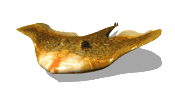
 Jawed Fishes
Jawed Fishes 
 Jawed Fishes
Jawed Fishes Placoderms were the first fishes with jaws and paired fins. In these fishes, bony elements reinforced the notochord and pairs of fins stabilized the body. Gill openings in the head became enlarged and fitted with teeth. They functioned as jaws. As the Paleozoic drew to a close, placoderms were replaced by cartilaginous and bony fishes.
Cartilaginous Fishes (Chondrichthyes)
Most are marine predators. All possess a streamlined body with a cartilaginous endoskeleton, gill slits, and fins. This group includes the sharks, skates, rays, and chimaeras.

 Sharks are
formidable predators with their powerful jaws and teeth (replaceable).
Sharks are
formidable predators with their powerful jaws and teeth (replaceable).
Shark video (largest fish) taken at the Seattle Aquarium (Audio - Not Important).
Video of shark teeth taken at the Monterey Bay Aquarium.
 Skates and
rays live on the
ocean bottom where they feed on invertebrates. Some can jolt prey with electricity or sting with
a venomous tail spine.
Skates and
rays live on the
ocean bottom where they feed on invertebrates. Some can jolt prey with electricity or sting with
a venomous tail spine.
Sting ray video taken at the Monterey Bay Aquarium.
Chimaeras (ratfishes) are almost scaleless, with a body resembling a rat.

 Bony Fishes (Class Osteichthyes)
Bony Fishes (Class Osteichthyes)
This class includes 96 percent of living fish species. Bony fishes are the most numerous and diverse of the vertebrates. They are descendants of ancestors that arose in the Silurian period and have radiated into nearly every aquatic habitat. There are three subclasses:
 Ray-finned fishes very from torpedo shape
to eels to the peculiar
sea horse.
Ray-finned fishes very from torpedo shape
to eels to the peculiar
sea horse. Tuna video taken at the Monterey Bay Aquarium.
Goldfish video (Audio - Not Important) taken at the Exploratorium in San Francisco.
Eel video taken at the Monterey Bay Aquarium.
Leafy sea dragon (similar to sea horses) video taken at the Monterey Bay Aquarium.
The lobe-finned fishes are highly maneuverable thanks to their fins, which are supported by rays that originate from the dermis. They bear fleshy extensions on the body.
Lungfishes in Australia live in water and gulp air at the surface until the pool they are in dries up. Then they encase themselves in mud waiting for the next rainy season.
This animation (Audio - Important) compares the gill supports of fish.
If it's between 7am and 7pm you can take a quick trip to the Monterey Bay Aquarium to watch the fish on the Kelp Cam. Below each of the live cams is a video clip of Giant Blue Fin Tuna or fish feeding.
REVIEW: The vertebrate jaw first appeared in which organism?� �
REVIEW: Sharks, rays, and skates belong to what group?��
REVIEW: Of all existing vertebrates, _____ are the most diverse.��
PREVIOUS
NEXT
LECTURE 17 INDEX
MAIN INDEX